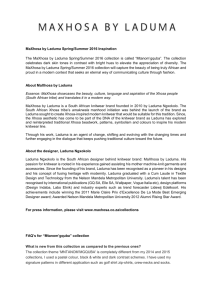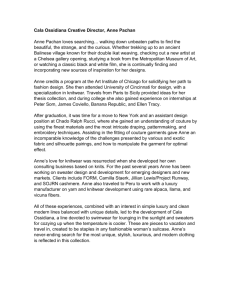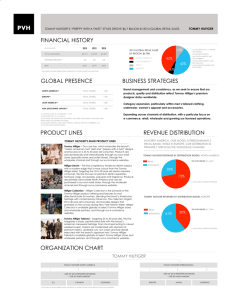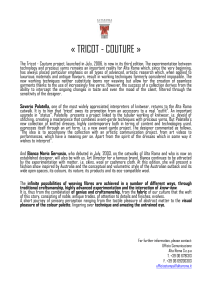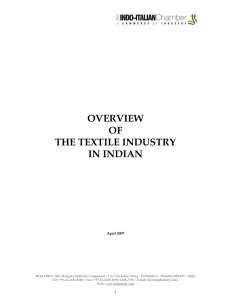PROJECT REPORT ON KNITWEAR INDUSTRY: TOMMY HILFIGER
advertisement
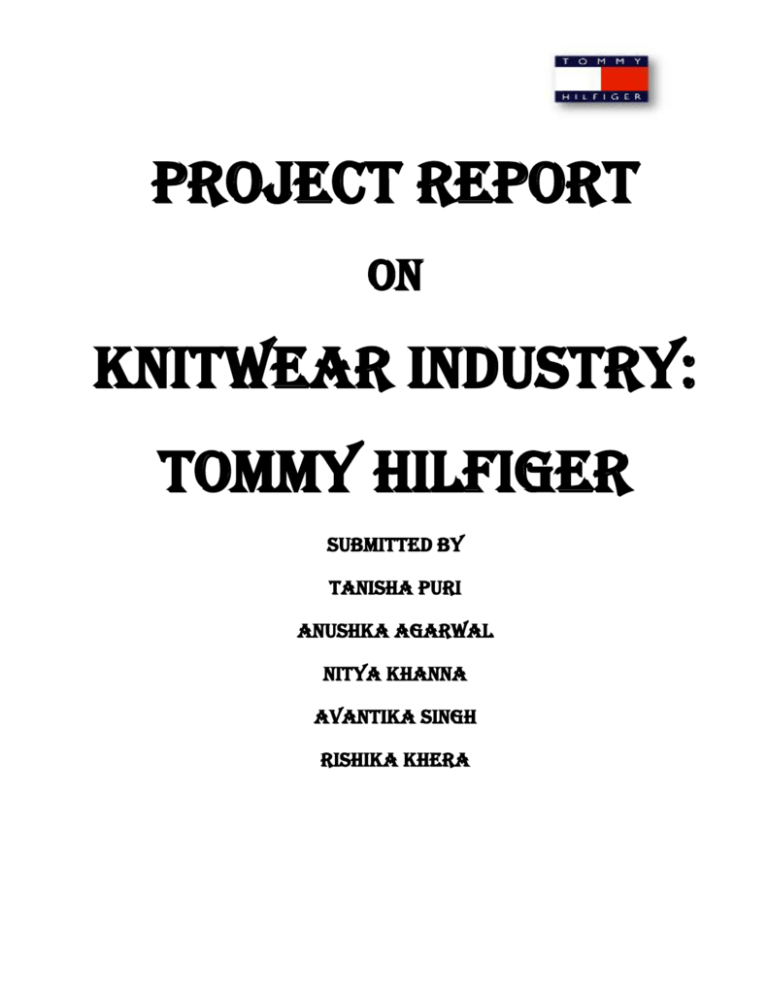
PROJECT REPORT ON KNITWEAR INDUSTRY: TOMMY HILFIGER SUBMITTED BY TANISHA PURI ANUSHKA AGARWAL NITYA KHANNa AVANTIKA SINGH RISHIKA KHERA TABLE OF CONTENTS TOMMY HILFIGER: overview Hilfiger in India Profile of competitors Indian textile industry Knitwear industry: India GROWTH of industry Export import overview Factors affecting cost Recent trends in the industry Opportunities and threats PEST SWOT References INTRODUCTION The Tommy Hilfiger brand was launched in 1985. Tommy is a range of clothing designed to bring 'American classics with a twist' to consumers. Today, those consumers represent people from all races and backgrounds and can be found in practically every country around the world. As a truly global brand, Tommy's preferred suppliers are those who can fully appreciate each individual marketplace. Tommy is a range of clothing designed to bring 'American classics with a twist' to consumers. The company’s apparel products are recognised throughout the world for their classic and timeless designs. OVERVIEW OF the Company • Tommy Hilfiger Group is a multi-billion dollar global apparel brand • Since 1985, the Company’s strategy has been to develop and a highly recognizable lifestyle brand. • The Company seeks to deliver superior styling, quality and value to its consumers worldwide. • Tommy Hilfiger Group has become a 3 billion EUR worldwide apparel and retail company. Tommy Hilfiger in India • Tommy Hilfiger was bought to into India through a joint venture between the Murjani group and the Lalbhai group, which owns the Arvind brand. • Called Arvind murjani brands private limited, the joint venture has entered into a licensing agreement for marketing and distribution of Tommy Hilfiger apparels in India. • ABM introduced Tommy Hilfiger in freestanding speciality stores across the country in spring 2004. • Tommy Hilfiger responded to the diversity of his customers by adding more variety to his clothing line and has succeeded in making clothing that many people enjoy wearing. His fragrances have been a huge success as well. The clothing line has expanded by including home products, eyewear, footwear, swimwear, jewelry, and divisions such as Tommy Hilfiger Athletics. Tommy Hilfiger is a true American Designer. Profile of COMPETITORS While older companies like Levi-Strauss, Timberland or even Ralph Lauren have been slow in entering the mass designer fashion stakes--some being particularly wary of attempting to enter ethnically or racially identified areas of consumer culture—and while many other companies have been content with their long established market niches and hierarchies of market segmentation, the story of Hilfiger’s company are just the opposite. Beginning with a line of preppy looking, clean-cut and conservative sportswear--similar to that offered by The GAP, but somewhat more expensive--Hilfiger set out in the early 1990s to compete against department store staple lines like Ralph Lauren and Liz Claiborne with essentially Young Republican clothing. In the course of only a few years this basically khaki, crew and button-down WASP style, while remaining a constant theme in Hilfiger collections, has been submitted to variations which were intended to bring the product closer to Hip-Hop style—bolder colors, bigger and baggier styles, more hoods and cords, and more prominence for logos and the Hilfiger name. These variations on a house-in-the-Hamptons theme opened up the doorway to African- American consumers, and Hilfiger's status is often closely linked to his popularity among African-Americans. But at the same time, that market has clearly been only one focus for Hilfiger's ambitions, set on maintaining and expanding markets among nonblack consumers, and continually multiplying the range of products offered. In addition to hip-hop styles Hilfiger now sells golf wear, casual sportswear, jeans, sleepwear, underwear, spectacles, fragrances, and even telephone beepers. Tommy has recently moved into women wear, and offers a women's cologne to go with the popular men's line. Not content with crossing all these areas of the mass market, Hilfiger seems currently to be conducting a foray into more classic designer markets with high-fashion shows marked by his appearance at the British fashion shows in 1996 and by the introduction of a line of brightly colored menswear that was clearly his attempt to become more of a haute-couture designer. Hilfiger's success has been quite astounding since the initial public offering of TOM in 1992. The company now has over 850 in store department store sales points in the US. In addition there are now almost 50 Hilfiger speciality stores across the country--a figure that has almost doubled in the course of two years. The company's annual report in early 1996 showed that revenue in the last quarter of 1995 was over $130 million, a 47% increase over the previous year. The company's cost for goods sold was less than $72 million, leaving more than $58 million in gross profits--a rate of gross profits of more than 80%. The sound financial health of the company ensures its regular appearance on stockbrokers' to-buy lists, even though share prices keep rising. Early in 1995 the small consortium of TOM's original investors-which had bought the company from Mohan Murjani in the late 1980s--sold their remaining TOM stock for over $50 million, after a year in which the value of the stock had increased by 106%. Hilfiger himself was one of this small group, of course, and after his profit- taking he remained as an employee of the company drawing more than $6 million a year in salary. The economic success of TOM is explicable largely because the company has led the way in many of the aspects of mass customization. TOM's corporate strategies have been ahead of those of many of its competitors, and have always stressed the acceleration of product delivery, new forms of retailing partnership, innovative EDI usage for inventories and customer tracking--and of course, the speedy and timely introduction of new lines and redesigned goods, assuring consumers a wide range of product choices (something which Hilfiger himself sees as crucial in provoking and expanding demand). TOM has been especially willing--again, leading the field—to engage in what is now a standard industry practice of licensing. TOM has licensing agreements with some of the world's major clothing companies. This network of links has been methodically and aggressively built up in just the last few years: Pepe plc for jeans, Stride Rite for shoes, Liberty Optical for eyewear, Estee Lauder for fragrance, Russell Newman for shirts, Jockey for underwear, and so on. While licensing agreements probably have little impact on consumer consciousness, one advantage they have for a company like TOM is that they offer the borrowed cachet of known and respected manufacturers. This is all important in negotiating sales points with department stores and generally in testifying to the quality of TOM products. Most of TOM's retailing partnerships are with department stores, and in 1995 about 70% of Hilfiger's products were sold at those venues. Added to TOM's strategies for speeding up product design, delivery, and turnover, licensing helps ensure access to what is still the principal channel for clothing sales in the US where 65% of all clothing is sold by only 35 companies, the majority of which are chain retailers with department stores in malls and urban spaces all across the country Profiles of some rivals... Duke Duke, reportedly rated by ORG-MARG as the top T-shirt maker in the country. It also makes trousers, shirts, jackets, sweaters and thermal underwear. T-shirts account for 60-65 per cent of the company's total revenues. Domestic sales account for 80 per cent. Its overseas buyers include Gap, Wal-Mart and Target. Today, Duke embraces a complete vertically integrated garment manufacturing plant, with knitting, dyeing, processing, finishing, mercerizing, compacting, embroidery and printing under one roof. Duke Fashion (India) Ltd pioneered the T-shirt culture, and gradually established several new trends in knitted garments and fabric research. BENETTON When Benetton was started in 1989 in India, all they found themselves selling were jeans and T-shirts. Benetton now sells 1,500 styles as compared to the 400 they started with. The €1.7 billion Italian fashion company had entered India through a joint venture with DCM but now Benetton India is a wholly owned subsidiary after they broke up a few years back. LEVIS Levi's has excellent brand architecture in place and it is performing well. The market for denim, especially at the premium end, is growing between 15 and 20 %annually. The four sub-brands are pretty well straddled. It has 30%of the premium denim market in the country, and about 10 per cent of the overall market across price segments. REEBOK Reebok is the brand for sportswear — shoes, T-shirts etc — while Rockport is for a premium range of footwear and apparel marked by 3R’s — rugged, refined and relaxed. Entering India in 1995, Reebok has captured a market share of 50 per cent followed by Nike. Indian textile industry The textile industry is one of the oldest industries in India. It has played an important role in generating foreign exchange reserves and creating employment opportunities. The industry is very vast with over 30,000 readymade garments manufacturing units and employs nearly three million people (Indian Apparel Portal: 1998). It has been estimated that the size of industry is Rs. 78000 crore. The concept of readymade garments (apparels) is relatively new for the Indians. Traditionally, Indians preferred dresses stitched by local tailors, who had tailoring units in townships or cities and catered exclusively to local demand. The growing fashion consciousness during the 1980s and the convenience offered by ready-to-wear garments were largely responsible for the development of the branded apparel industry in India. Other factors which contributed to its growth were: Greater purchasing power in the hands of the youth, Access to fashion trends outside the country, and The superior quality of fabrics. KSA Technopak study shows that 48 percent of the population of India is in the age group of 15-44 years, and this group is already into ready-to-wear apparel. There is rapid growth in 15-44 years age group and this group has both the willingness and the ability to pay. Moreover, the spending on clothing and footwear is quite high in India, when compared to the developed countries. It is estimated that Indians spend 9% of their disposable income on clothing and footwear, which is significantly higher than the US (5%). Moreover, the expenditure on clothing is higher in the higher income levels. A study conducted by National Council for Applied Economic Research (NCAER) in the late 1990s revealed that there has been a gradual increase in the purchasing power of the people. According to the report, the population in the income range of Rs 45,000 -Rs 2,15,000 per annum was increasing at a fast pace. In 1997-98, there were 33 million households in this income group and this number is expected to increase to 75 million by 2006-07. Indian garments export business has made great strides in the past few years and today many of the leading fashion labels, from all over the world, are known to source their products from India. This speaks volume of India as a major supplier of top quality fashion garments. Indian Textile Clusters Cluster Location Guntur State AP Product Specialisation Powerloom & Cotton Ginning Powerloom Crochet lace Nagari AP Narsapur AP Pochampall AP Tie and dyeing y Anantpur AP Jeans/ RMG Sirsilla AP Powerloom Warangal AP Powerloom Delhi Delhi RMG/ Hosiery Gujara Ahmedabad RMG t Jetpur Gujara Textile printing (Rajkot) t Gandhinaga Gujara Powerloom r t Gujara Surat Powerloom t Gujara Vijapur Weaving t Harya Bhiwani Powerloom na Harya Gurgaon RMG na Harya Panipat Powerloom na Bangalore Karnat RMG Cluster Location State Maharasht ra Maharasht Mumbai ra Maharasht Nagpur ra Maharasht Pune ra Maharasht Solapur ra Balasore Orissa Dhenkanal Orissa Ganjam Orissa Nuapatna Orissa Amritsar Punjab Malegaon Product Specialisation Powerloom RMG/ Hosiery Powerloom, RMG RMG Powerloom Powerloom Powerloom Powerloom Tussar silk Powerloom Woollen Ludhiana Punjab knitwear Jaipur Rajasthan Garments Hand Jodhpur Rajasthan processing Kishangar Rajasthan Powerloom h Sanganer Hand block Rajasthan & Bagru printing Bhavani & Chennimal TN Home textiles ai aka Karnat Belgaum Powerloom aka Karnat Bellary Jeans aka Karnat Gadag Powerloom aka Karnat Mysore Silk aka Ernakulam Kerala Powerloom Faizlure Kerala Powerloom Kannur Kerala Handloom Mallappura Kerala Powerloom m Palakkad Kerala Powerloom Burhanpur MP Powerloom Chanderi MP Handloom Indore MP RMG RMG/ Jabalpur MP Powerloom Maheshwar MP Handloom Ujjain MP Powerloom Mahar Bhiwandi Powerloom ashtra Mahar Ichalkaranji Powerloom ashtra Madhavnag Mahar Powerloom ar ashtra Karur TN Madurai TN Rajapalya TN m Salem TN Surampatti TN Home textiles Tie & dye, hand printing,RMG Surgical textiles Tirupur TN Agartala Tripura Banda Gorakhpu r Jhansi Kanpur UP Powerloom Powerloom Knitwear/ Hosiery Handloom & Loin Looms Powerloom UP Powerloom UP UP Powerloom Hosiery Chikan Lucknow UP embroidery Mau UP Powerloom Noida UP RMG Varanasi UP Powerloom Kolkata WB Hosiery/ RMG Ranaghat WB Powerloom Source: D&B Research, UNIDO, SIDO Structure of the Textile & Apparel Industry in India Covers a Gamut of activities :From production of raw materials like cotton, jute, silk and wool to providing high value-added products such as fabrics and garments Wide range of raw fibres Natural fibres like cotton, jute, silk and wool to Man made fibres like polyester, viscose, acrylic and multiple blends of such fibres Plays a key role in the economy. Provides direct employment to an estimated 38 million people and contributes five per cent to GDP. Significant contributor to trade. Exports growing at 11.8 per cent estimated to grow at 15 to 18 percent. Financially strong players at the back end. State of the art spinning facilities Large weaving capacity. However, a major capacity is in the unorganized / small scale sector. Processing is the weakest link in the entire chain. Barring a few large, organized sector players, operating largely in the 100% Cotton and / or Cotton Rich blends in finer counts & in denim, this sector is unorganized In Towels & Home Textiles, some significant players that compete strongly with Pakistan, Turkey & China Garment making has a number of small to large players. Larger companies expanding capacity rapidly. Most have Full Package capability. Large number of retailers at the front end, though only a few are big (relatively). RAW MATERIALS • Abundant availability of raw materials – largest cotton acreage. • One of the largest polyester yarn producers SPINNING • Accounts for about 22 per cent of the world’s spindle capacity • Second highest spindlage KNITTING • Highly fragmented, small-scale and labour-intensive • Highest loomage in the world and contributes about 61per cent to the world Knitwear industry in India Tirupur, Tamil Nadu is the Knitwear cluster of India. This cluster is widely recognized as a `dynamic’ cluster with necessary `vertical’ depth, critical mass of enterprises as also appropriate factor conditions. This has helped it to be largely export oriented in terms of over eighty percent of its €1.3 billion a year turnover. The growth of the cluster has been propelled by strong associations. Our interventions emphasized on cluster wide dissemination on several critical areas as also catalyzing several new pursuits. Features of Knitwear Industry • Low cost labour force, sizeable supply of fabric, raw material and spinning and dyeing facilities. • Existence of many associations for the knitwear cluster well connected with each other • TEA (Tirupur Exporters Association) works together with the Government and local companies to ensure better infrastructure and other facilities for the cluster. • Design oriented production – companies investing in design proposals to clients • Formation of NIFT TEA FASHION INSTITUTE – school for apparel design set up to help the exporters • Major exports to European brands : Upim, Diesel, Marlboro, Rinascente, Champion, Liberti, C&A, Wallmart, JC Penny, GAP, Mark & Spencers, Sara Lee,Tomy Hilfiger, Karstadt Quell etc • Tirupur garment exports amount to €1.6 billion international market and €454.5 million in the domestic market. The sector is competitive and likely to see increased investment from global players(KPMG ANALYSIS) GROWTH OF THE INDUSTRY • In India the knitwear industry after struggling for many years is according to many experts preparing to take off. It is not surprising that the knitwear industry is gaining prominence in India as India has a history of a rich industry for textiles and fashion. Today there are over 30 knitwear companies of significance in India. These companies produce garments that meet international standards through their own work as well as through assistance provided by the International Wool Secretariat. • The knitwear industry of Ludhiana is gearing up to adopt measures that will ensure that it remains competitive. • A Memorandum of Understanding was signed between the Federation of Knitwear, Textile and Allied Industries Association and Apex Cluster Development Services, a cluster development consultancy, to enable Ludhiana’s knitwear industry competitive. • There is tremendous potential for exports from India of woollen knitwear,” enlightens Dr. Chaudhuri. But the West European market is fiercely competitive. “Fortunately in India it is a sellers market so it is easy,” he adds. But India can also be very competitive price-wise. The IWS has helped Indian manufacturers to learn about the latest trends in knitwear fashion. IMPORT EXPORT SCENARIO Today there is a global market for hand knitwear products; however, most of this international market remains untapped by India. India is not currently a large exporter of knitwear garments; rather the country focuses on its domestic market. India has great potential to expand into the global knitwear market as its products are competitive particularly from a price standpoint. As time continues to progress India is continuing to learn to keep up with and compete with the international market. The domestic market for knitwear items is particularly strong in the local regions of Northern India due to the weather that is experienced there. Items are often purchased locally at markets or handmade at home while the international market relies on online purchases. Immediately after the cessation of ATC (Agreement on Textiles and Clothing) in December 2004, limiting exports of textiles and garments from India, there was a 25% spurt in exports of garments in the following year. This has since slowed down to around 10%. A number of supplying countries from Asia have come into existence, notably, Bangladesh, Vietnam, Srilanka, Cambodia and Pakistan resulting in cut-throat competition in the supply of popular varieties helping to bring down prices. India has had to adopt innovative practices by upgrading the quality of product in order to sustain (leave alone increase) her market share in the world community. In recent years, appreciation of the Indian Rupee vs.US $ and the downslide in US economy has had a restraining effect on garment exports from India, but the industry is now coming to terms with the development. Knits have been more successful especially in export channels. Strong production clusters like Tirupur and Ludhiana have led to growth of accessories sector as well, albeit slowly.The immense growth of the knitwear industry has motivated the manufacturers to explore overseas market. During the financial year 2009, exports of woven and knit garment exports to South Africa amounted to $42.51million USD. China is a major supplier of garments to South Africa, followed by India and Mauritius. Looking at export shares, Korea (6%) and Taiwan (5.5%) are ahead of India, while Turkey (2.9%) has already caught up and others like Thailand (2.3%) and Indonesia (2%) are not much further behind. The reason for this development is the fact that India lags behind these countries in investment levels, technology, quality and logistics. The knitwear industry, which had registered Rs 10,000 cr in exports last year, is finding it difficult to maintain the 20 percent growth rate it has maintained for the past few years. They may register a growth of 5 percent. Though the industry had shown a steady export growth, this year the target was scaled down by 25 to 30 percent, and this year it has been further downsized to 5 to 10 percent. The demand of the exporters for an upward revision of prices by about 5 percent has been met with resistance by the importers, who find the cost of import from China competitive. India has great potential to expand into the global knitwear market as its products are competitive particularly from a price standpoint. As time continues to progress India is continuing to learn to keep up with and compete with the international market. The domestic market for knitwear items is particularly strong in the local regions of Northern India. The rate of modernization is also found to be very low as compared to the major competing countries. We have to improve on indigenous technology development and the government has to take initiatives in this regard apart from present technology Up gradation and Fund schemes and other measures. Every year India imports nearly 20 million kilogrammes of greasy wool from Australia for fabrics and shawls and nearly 16 million kilogrammes of clean scoured for non-apparel items. Nearly six million kilogrammes of wool is used per annum in India to produce knitwear. The power loom sector and the cotton yarn industry are the worst hit, as the appreciating rupee has resulted in fewer export orders, and lesser margins. Though the industry had shown a steady export growth, this year the target was scaled down by 25 to 30 percent, and this year it has been further downsized to 5 to 10 percent. The demand of the exporters for an upward revision of prices by about 5 percent has been met with resistance by the importers, who find the cost of import from China competitive. As far as the export market is concerned. India’s performance in woollen garments is quite negligible,” informs Dr. S.K.Chaudhuri, Director of IWS London, Indian Branch. With Italy being the number one woollen fabric manufacturer and Germany coming a close second there is not much chance for new entrants. In the knitwear division 80 per cent of the world exports are from Italy. Taiwan, Hong Kong and Mauritius. Factors affecting cost In terms of cost, India has an advantage over comparative countries • This inherent strength in availability of raw materials prevents any supply-side shocks • Ample availability of a variety of raw materials at low costs • Availability of skilled labour and low labour costs • Growing demand in domestic market • Government support Do more indepth analysis RECENT TECHNOLOGY USED IN THE KNITWEAR INDUSTRY The art of knitting has come of age. From hand knitting to hand operated machines was a long way. Gradually it upgraded to power operated V-Bed and circular knitting, and then it leapfrogged to microprocessor controlled machines. Now lately CAD/CAM has revolutionized the knitting industry. However, in the developing countries they still use manually operated flat and V-bed knitting machines for their bulk production since cheap labour is available. The other reasons being flexibility in knitting and economical for smaller design lots. However, quality on these machines remain a suspect because settings of stitch length and feed tensions may vary from machine to machine, which pose problems in sizing. The weaving and knits sector lies at the heart of the industry. In 2004-05, of the total production from the weaving sector, about 46 per cent was cotton cloth, 41 per cent was 100% non-cotton including khadi, wool and silk and 13 per cent was blended cloth. Three distinctive technologies are used in the sector – handlooms, powerlooms and knitting machines. They also represent very distinctive supply chains. The handloom sector (including khadi, silk and some wool) serves the low and the high ends of the value chain – both mass consumption products for use in rural India as well as niche products for urban & exports markets. It produces, chiefly, textiles with geographical characterization (e.g., cotton and silk sarees in Pochampally or Varanasi) and in small batches. Handloom production in 2003-04 was around 5493 mn.sq.meters of which about 82 per cent was using cotton fibre. Handloom production is mostly rural (employing about 10 million, mostly, household weavers) and revolves around master-weavers who provide designs, raw material and often the loom. Weaving, using powerlooms, was traditionally done by composite mills that combined it with spinning and processing operations. Over the years, government incentives and demand for low cost, high volume, standard products (especially sarees and grey cloth) moved the production towards powerloom factories and away from composite mills (that were essentially full line variety producers). While some like Arvind Mills or Ashima transformed themselves into competitive units, others gradually closed down. In 2003-04, there remained 223 composite mills that produced 1434 mn. sq. mts. of cloth. Most of these mills are located in Gujarat and Maharashtra. Most of the woven cloth comes from the powerlooms (chiefly at Surat, Bhiwandi, NCR, Chennai). In 2005, there were 425,792 registered powerloom units that produced 26,947 mn. sq. mts of cloth and employed about 4,757,383 workers. Weaving sector is predominantly small scale, has on an average 4.5 power looms per unit, suffers from outdated technology, and incurs high co-ordination costs. Knits have been more successful especially in export channels. Strong production clusters like Tirupur and Ludhiana have led to growth of accessories sector as well, albeit slowly. The hosiery sector, on the other hand, has largely a domestic focus and is growing rapidly. OPPORTUNITIES AND THREATS PEST analysis Political-legal Complete elimination of the quota restrictions under the Multi Fibre agreement (MFA) since January 2006 Inflexible Indian Labor laws De-reservation of garments from SSI sector since 2001 Economic All capital goods in the textile sector have been covered by Export Promotion Capital Goods scheme, which attracts 5 per cent customs duty without any countervailing duty. Union budget 2006-2007: Ad valorem component of customs duty on textile fabrics and garment has been reduced from 20% to 15%. Per Capita income spent on branded garments is less than that in the developed countries. Demand for branded garments is more income elastic than price elastic Socio-Cultural Increased disposable income of Indian households People are exposed to the western lifestyle and there is a drastic shift in their taste and preferences Continuing shift in customer preference towards ready-to-wear products Consumers more aware of brands and are now more style and brand conscious. Styles and trends changing faster than ever which reduces the shelf life of fabrics as well as readymade garments Customers accepting the casual and colorful look even at work. Technological Pedal-operated machines in the 60s, the industry moved on to power-operated machines and steam presses in the mid-80s, started assembly line manufacturing in the late 80s and then entered the phase of using computerized machines. This in short summarizes the usage of technology in garment industry over the years. IT tools being used for tracking of stock keeping units. IT helps improve the supply chain management, for direct marketing, for identifying customer preferences in multiple geographies. Regular innovations in color, style, design, fabric, finish and fit are necessary in the dynamic industry, which in turn requires automated machinery and IT solutions. Automation brings down the total cost of production by at least 10 to 15 per cent, out of which the saving on fabric alone would be 5 to 7 per cent. Cost of technology is however a deterrent E-retailing SWOT Analysis Strengths Self reliance Manufacturing flexibility Abundance of raw material production Design expertise Availability of low cost skilled labour Growing economy and domestic market Progressive reforms Presence across the value chain Weakness Highly fragmented industry High dependence on cotton Lower productivity and Cost Competitiveness Declining mill segment Technological obsolescence Effect of Historical Government Policies Non participation in trade aggrements Opportunities End of quota regime Shift in domestic market to branded readymade garments Increased disposable income Emerging mall culture and retail expansion Research and Development and Product Development Textile economy to grow to $ 85 bn. by 2010. Creation of 12 million new jobs in Textile Sector. To increase Indias share in world trade to 6% by 2010. Achieve export value of $ 40 Billion by 2010. Modernisation and consolidation for creating a globally competitive industry. The future outlook for the industry looks promising, rising income levels in both urban and rural markets will ensure a rising market for the cotton fabrics considered a basic need in the realm of new economic reforms (NER) proper attention has been given to the development of the textiles industry in the Tenth plan. Total outlay on the development of textile industry as envisaged in the tenth plan is fixed at Rs.1980 crore. The production targets envisaged in the terminal year of the Tenth plan are 45,500 million sq metres of cloth 4,150 million kg of spun yarn and 1,450 million kg of man made filament yarn. The per capita availability of cloth would be 28.00 sq meters by 2006-2007 as compared to 23.19 sq meters in 2000-01 showing a growth of 3.19 percent. The export target of textiles and apparel is placed at $32 billion by 2006-2007 and $50 billion by 2010. Threats Stiff competition from developing countries; especially China Pricing pressure Locational disadvantage International labour and environmental laws Competition in Domestic Market Ecological and Social Awareness Regional alliances Threat of New Entrants: New entrants to an industry can raise the level of competition, thereby reducing its attractiveness. New entrants frequently bring additional capacity to an industry. Thus it is possible that prices will be bid down and industry profits diminished. In the knitwear industry, new entrants could quickly enter the industry because it costs little in time or money to enter the market and compete effectively, and there are few economies of scale in place, or have little protection for the key technologies, so that new competitors can quickly enter the market. Threat of Substitutes: Substitutes are new products (or services) that are quite different than the original product or service. A threat exists when a product’s demand is affected by the price change of a substitute product. When the demand for a product declines due to either lower prices of better performing substitute product, low brand loyalty, new current trends or low switching cost. There is a high threat of substitutes in the knitwear industry such as sweater, cardigan and cashmere or other dressing and the fashion trend change in every season, people wants to buy the fashionable clothing and make the elastic of the knitwear is very high. Bargaining Power of Buyers: A ratio of suppliers to buyers in the market is the foremost factor affects the buyer’s power. If there are many suppliers and only a few buyers, the buyer’s have the power to negotiate the price. RECOMMENDATION The government should take steps in improving the Knitwear Industry. Improve the technology used by the industry. Labour should get a better environment to work in and fair wages. The Knitwear Industry should be innovative so that it doesn’t get choked out due to outdated technology. India should participate in trade agreements and should take help from the developed countries. The pricing pressure should be reduced. Latest use of technology and by improving the knitwear industry competition can be reduced. REFERENCES • • • • • • Dictionary of textiles-Phyllis G Tortora &Robeet S Merkel Encyclopedia of textiles-Judith Jerde Textiles today a global survey of trends & traditions Knitted clothing technology-Tery Brackenbury Google search engine http://global.tommy.com/ General comments Provide Intext citations (Otherwise no grades will be given) Do Proper Formatting Follow the structure given in the brief Provide Introduction Do more indepth analysis of cost factors First give overview, then History Segment wise study Product differentiation factors Recent trends ? Supply ? Taste and Preferences affecting demand Other aspects given in the brief Diagrams? Provide Indian competitors and overview of Indian Knitwear industry
